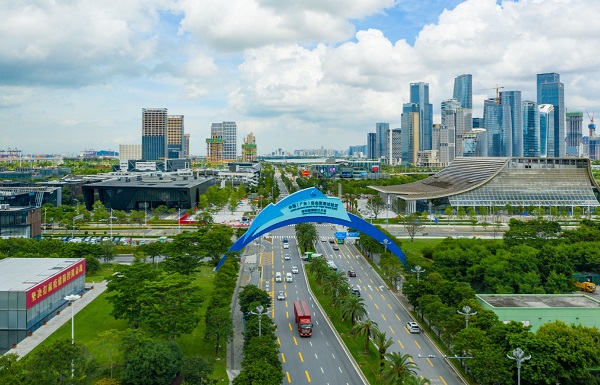Guangdong establishes five city clusters to bolster development

An aerial view of the Qianhai free trade zone in Shenzhen, Guangdong province. [Photo by Lu Li/For China Daily]
Province aims to sharpen its competitive edge as global economic powerhouse
Guangdong's provincial government has delineated five city clusters — Guangzhou, Shenzhen, the west coast of the Pearl River Estuary, Shanchaojie and Zhanmao — which will help the province achieve high-quality development.
Ai Xuefeng, director of the Guangdong Provincial Development and Reform Commission, said urbanization is the inevitable path of modernization, and cultivating these clusters or "megacities" is an important means to promoting high-quality development in the province.
He added that the urbanization rate of the permanent population in Guangdong neared 75 percent last year, entering a mature and stable stage of urbanization.
"After years of development, Guangdong now has the conditions, foundation and necessity to accelerate the cultivation and development of megacities to further optimize the spatial pattern of the population and economy, and to enhance the endogenous power of the Pearl River Delta, Beibu Gulf and the coastal urban clusters in Guangdong, Fujian and Zhejiang provinces," Ai said.
"It will help form new advantages for regional development and provide strong support for Guangdong to continue to take the lead in promoting the Chinese path to modernization in the country."
Guangzhou is slated to become the main engine for high-quality development of the province, a global production base, a national demonstration zone for high-quality urbanization and a model area for the integration of manufacturing and service industries.
By 2030, the comprehensive strength of the Guangzhou megacity, which includes the provincial capital as well as Foshan and parts of Zhaoqing and Qingyuan, will be significantly enhanced, with an urbanization rate of 88 percent for permanent residents.
With Guangzhou Baiyun International Airport and Nansha Port, Guangzhou megacity is expected to become a global transportation hub.
Shenzhen megacity, which includes Shenzhen, Dongguan, Huizhou and the Shenshan Special Cooperation Zone, is expected to become an innovative, international and modern megalopolis with Chinese style and world-class standards by 2035.
The west coast of the Pearl River Estuary, including the cities of Zhuhai, Zhongshan, Jiangmen and Yangjiang, is expected to become an important growth pole for the Guangdong-Hong Kong-Macao Greater Bay Area, an advanced equipment manufacturing base with global influence, and a high-quality development area suitable for living, working and travel.
The Shanchaojie and Zhanmao megacities, located in the eastern and western parts of Guangdong respectively, are expected to be important production bases to promote regional coordinated development in the province. Shanchaojie includes the cities of Shantou, Chaozhou and Jieyang, while Zhanmao consists of the coastal cities of Zhanjiang and Maoming.
Li Xiaolin, deputy director of the third regional office of the National Development and Reform Commission's Regional Development Strategy Research Center, said the planning of the megacities reflects the comparative advantages of different regions and their differentiated development.
"The planning of the five megacities respects the differences in the development stages of different urban agglomerations, designs of the spatial structure, ecological and industrial patterns, infrastructure and the public service facility layout of urban agglomerations in a differentiated manner," she said.
According to official statistics, the permanent population of the five megacities in Guangdong reached 108 million last year, accounting for 85.4 percent of the province's total. The disposable income of residents reached 5.8 trillion yuan, representing more than 90 percent of the province's total. The province, with a population of more than 127 million, is the country's most populous region and an economic powerhouse.
All rights reserved. Presented by China Daily









